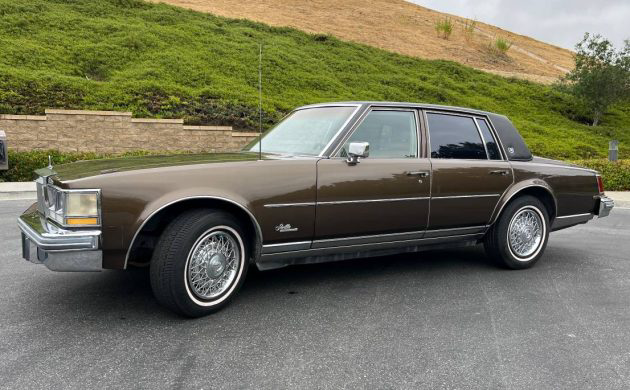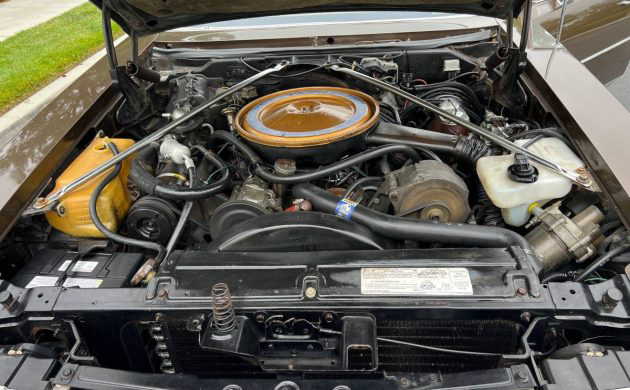The 1970s marked a shift in philosophy amongst American prestige car manufacturers. Companies like Mercedes-Benz and BMW proved that premium models did not have to be large land yachts to provide a luxurious ownership experience. Cadillac rose to the challenge in 1976 by releasing the First Generation Seville. It may have been the smallest car in the marque’s range that year but was also the most expensive. This 1976 Seville is an original survivor, and its overall condition is impressive. It has few apparent needs and is ready to hit the road with a new owner behind the wheel. The Cadillac is listed here on Craigslist in Irvine, California. The seller set their price at $15,000, and I must say a big thank you to Barn Finder PRA4SNW for spotting this beauty.
It is fair to say that without the rise of prestige imports, especially from countries like Germany, the Seville may never have existed. Some traditional buyers were turning their backs on larger models, becoming irresistibly attracted to smaller vehicles offering equivalent luxury and a more engaging driving experience. The scope of this philosophical change is best gauged by comparing vital statistics between the Seville and the company’s DeVille range. Not only is the Seville over two feet shorter than its sibling, but it is also an astounding 1,000 lbs lighter. There is no doubt that Cadillac had the Germans firmly in its sights when developing this new model. This 1976 Caddy is a dry-climate survivor that has spent its life in California. That makes its rust-free status unsurprising, while the lack of deterioration to its Demitasse Brown paint and vinyl top suggests it spends its downtime safely hidden away from harsh UV rays. I’m unsure whether the rear bumper fillers might be showing signs of collapse, which is a common issue. If that is the case, it is the only issue worth mentioning. The paint is close to perfect, the panels are as straight as an arrow, and the trim, glass, and wire wheel covers are excellent. I think the back windows may feature aftermarket tinting, but that seems to be the only exterior change.
Traditional Cadillac buyers expected a V8 under the hood of their new purchase, and the company delivered with its Seville. It had toyed with several potential drivetrain configurations but decided that the 350ci Oldsmobile V8 should send its 180hp and 275 ft/lbs of torque to the road via the rear wheels and a three-speed Hydramatic transmission. The company added fuel injection to this V8 to improve its manners in an era when tighter emission regulations often resulted in engines that were pretty unrefined. Outright performance was rarely a consideration for Cadillac buyers, and although the Seville lost out in a head-to-head competition against the BMW 530i, it could show the Mercedes-Benz 280 a clean set of heels. The seller recently installed a new fuel tank, pump, injectors, and tires and treated the vehicle to a complete service. It has a current Smog Certificate and is a turnkey proposition for its new owner. It runs and drives perfectly, allowing the new owner to fly in and drive it home.
If this Cadillac has a weak point, that honor may fall to its interior. It isn’t horrendous and is unquestionably serviceable. However, some faults and defects prevent it from achieving perfection. The dash has a crack above the driver’s side vent outlet, and there is at least one crack in the pad. The wheel exhibits wear, especially around the spoke. I believe the carpet may have some patchy fading, but there is no significant wear. The leather seatcovers carry typical wrinkles and creases, but the lack of wear in them or the other upholstered surfaces is a bonus. Buyers paid a premium for the smallest vehicle in the 1976 Cadillac range, so the company loaded the interior to help potential buyers justify the price. Standard equipment includes climate-control air conditioning, power windows, power locks, power front seats, cruise control, a remote trunk release, a rear defogger, and an AM/FM radio/cassette player.
The 1976 Seville represented a moment when Cadillac chose to be bold and daring. Resting on its laurels as the producer of ultra-luxurious land yachts would have been a safe approach, but it decided to tackle the Europeans head-on. The Seville sold in respectable numbers, but many believe the results would have been significantly better if the sticker price were lower. The “baby” Caddy holds its own in the classic market, with values remaining steady during a period when many more fancied models fell sharply. The seller’s price for this car is about average for a tidy and unmolested Seville, and I’m unsure whether the seller will taste success. However, it is the classic world, and anything can happen. Are you tempted?







One of the sharpest of the smaller Caddies ever made.
At least until Bill Mitchell redesigned it with the infamous “Bustle Trunk” in the 1980 model year! Then it grew and became bloated and ugly, like so many Detroit small cars of the time.
Beautiful condition, but would put the remind-me-its-not-1976 steering wheel cover & “colorless” floormats in some other car.
I would one day like to see an original good condition ’75-’77 black on black Merc 4 dr Monarch with round headlites, like the 1 in the magazine ad.
Wait…that series of Seville was REAR-wheel drive?? I did not know that; I thought it was always a FWD car. And fitted with an OLDSMOBILE mill?? Learning something new all the time.
That makes it more (to me) related to the Cutlasses of the early-’80s. I always thought that this series of Seville looked like a Cutlass with a fancier dressing…or, considering the actual time-span, the Cutlass looked a demure first-gen Seville. It looks like Cadillac passed down that design to Oldsmobile for their use when Cadillac went with the truncated-trunk look in 1980. Now, learning about the Olds mill and RWD setup, that seems to further bolster my theory. I have a similar theory regarding the second-gen Toronado being a hand-down of the first-gen Eldorado design.
It’s actually like a 1st (tho more 2nd) gen camaro/firebird! & ’68(tho more ’75)-’79 nova underneath with front subframe, unibody rear section,& rear LEAF! springs. Not a full frame car.
It is not related to the Cutlass in any way, but was developed from the Nova platform. The chassis was stretched 3 inches to give more back room for rear passengers, and 1,000,000 pounds of rubber grommets replaced to isolate road noise
Cadillac’s 472 in.³ eight was far too large to fit into that engine compartment, and not necessary either
But the 472 would have been fun!!
4300lbs of elegance. 👌
The Seville’s size may have been “international,” but the Seville experience was definitely American. The wide, cushy seats, straight-across dashboard w/o console, wire wheel covers, and vinyl roof covering (necessary to hide the joint between the stock Nova roof and the Seville’s formal roof extension) were all distinctly American features. Ride and handling were skewed toward comfort, another digression from European themes. The Seville was probably the finest car built in America at the time, and I’ve always appreciated the car’s classy look (make mine a black/silver ’77 Elegante, please), but in spite of the advertising of the day, the target audience was Cadillac buyers looking for something smaller, not European buyers looking for something American.
As I’ve said in the past, I worked for a Cadillac dealership in 81-82 and we had a 76 Seville as a shop driver to take customers to their destination after dropping off their vehicle for service. Looked a lot like this one except carmel brown. I drove Fleetwoods, Eldorado’s coupe’s, sedan’s and Cimmaron’s. Various years and option packages and other than the 81 Fleetwood 2 door, I would’ve taken the Seville over all others. Comfortable and the only one better in the corners was the “yuck” Cimmaron which was the ONLY thing that car had going for it. Then they changed the drive train and all Cadillac’s went to crap for a while. Not a bad thing to say about the early Seville. The design may have gotten better in the later years but wouldn’t own one because of the motor. Why can’t people leave a good thing alone?
Fully agree with you about the 81 FW coupes. I couldn’t afford one when they were new, and all I could ever find used were 82s, and as we all know, that would not only have been a gutless slug, it would’ve self-destructed well before its time.
because gas prices went through the roof again in 1979 and customers wanted cars that got better mileage. that cast-iron block was heavy!
GM panicked and rushed the HT4100 to market before it was ready. Otherwise, it would’ve been a brilliant engine (with two more years of development.)
Classy color combo.
The Good: Olds 350 V8 with EFI. The Bad: A Nova under the skin. The Ugly: Still drove like the big Cadillacs. with numb steering and soft, flaccid suspension. Surprisingly, more were bought by women who wanted the Cadillac experience without the huge size of a DeVille or Eldorado. The good news is that most upgrade parts for a Nova will fit, including suspension and handling parts.
I don’t think it’s surprising that it’s sold mostly to women because GM’s data showed that not only were more and more of its best customers looking at Mercedes-Benz in the late 60s, but many of those customers were women, tired of the Nimitz class cars that were appearing in showrooms
Did they reuse the brown paint from my 72 nova?
I may have missed it in a very long description, but that front grill is a cheap aftermarket piece of crap from Jc Whitney
it absolutely ruins the car for me
The original 76 Grill is a nice simple egg, crate design without a fake Rolls Royce design.
Agreed, that fake RR grille looks stupid and so 70s. Get a correct steering wheel and dash pad and even I might be interested.
Like you, I’ve never like the RR grill, but it’s simple to put the ’76 grill back on. That is the correct steering wheel! After ’76 Cadillac went to a horrible steering wheel!
The front grill was actually a factory option. Check out the 1975 press releases!
Lovely Seville. Lose the grille cap and steering wheel wrap and it’s practically restored.
That is a 76 steering
As with anything listed on Craigslist my first concern would be who is the real owner! I had a Cadillac Eldorado Collector series for sale on Ebay a few years back and got a tip from a fellow Ebayer that my car was listed on Craigs list in the Mississippi area. Sure enough there it was, same pics same description. It happens too many times! Personally I wouldn’t buy anything from craigslist!
The filler on the rear bumper looks God awful.l owned a 78 Elegante Seville brown and gold.lt was truly a remarkable car all the way down to the real wire wheels. But for some reason the previous owner installed a Chevy 305 with FI. It was crap.l reinstalled a Olds 350 and it ran like a dream. One of the finest cars l’ve ever owned.